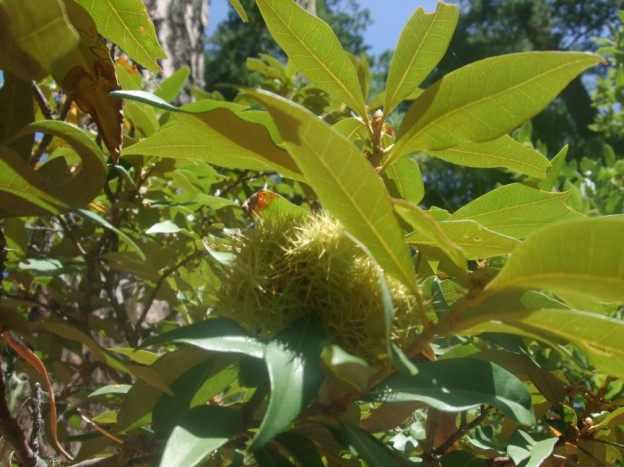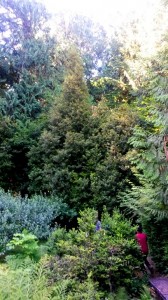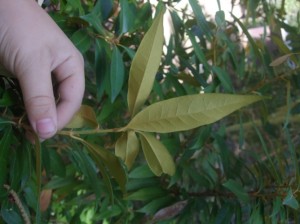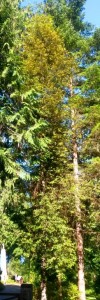Golden Chinquapin The Beech Family–Fagaceae
Chrysolepis chrysophylla (Douglas x Hook.) Hjelmqvist
(Cry-so-LEE-pis cry-so-FILL-uh)
Names: This evergreen tree has also been known as Castanopsis chrysophylla; Castanopsis means resembling chestnuts, (the genus Castanea). Chrysolepis means golden scales; chrysophylla means golden leaves. Both refer to the golden scales on the undersides of its leaves. Chinquapin (also spelled Chinkapin) is thought to be from an Algonquin term for chestnut.
Relationships: Golden Chinquapin is a relative of chestnuts. There are only two species in this genus; the Golden Chinquapin (aka Giant Chinquapin) the other is the Bush Chinquapin, Chrysolepis sempervirens, a shrub of California and southern Oregon.
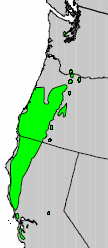
Distribution of Golden Chinkapin from USGS ( “Atlas of United States Trees” by Elbert L. Little, Jr. )
Distribution: Golden Chinquapin is also mostly found in California and Oregon with two small disjunctive populations in Washington; one in Skamania County along the Columbia River Gorge, the other in Mason County close to the Hood Canal. It is listed as a sensitive species in Washington State.
Growth: Golden Chinquapin grows slowly to 30-100 feet (10-30m).
Habitat: It is usually found on dry, open, south-facing sites and rocky ridgetops. It can also be found in fairly thick woodlands.
Diagnostic Characters: This shrubby tree is easily recognized by its dark, glossy, lance-shaped leaves with golden scales on the undersurface. It produces creamy, white flowers in upright catkins sometime between February and July. In the fall, one to three nuts are produced in a spiny burr, resembling the husk of chestnuts. The bark is smooth on young trees; on older trees it is thick and heavily furrowed, broken into reddish plates.
In the Landscape: Chinquapin is best grown as a specimen tree in drier parts of your garden. Its rarity in our area and its distinctive appearance can add a contrasting element of texture to your landscape.
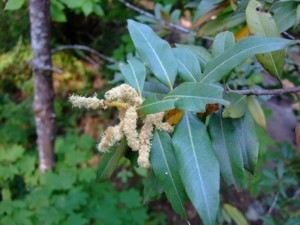 Phenology: Bloom Period: Mid-June to mid-July. Nuts ripen in mid-August to early September; seeds are dispersed from September through December by birds and rodents, but will also just drop to the ground.
Phenology: Bloom Period: Mid-June to mid-July. Nuts ripen in mid-August to early September; seeds are dispersed from September through December by birds and rodents, but will also just drop to the ground.
Propagation: Sow nuts as soon as they are ripe, but protect them from rodents. Because of its sensitive status in Washington, be very conscientious and respectful when collecting in the wild!
Use by People: The wood of Golden Chinquapin is hard and strong but is rarely found in sufficient quantities to be useful commercially. The nuts were roasted and eaten by natives of California and Southern Oregon.
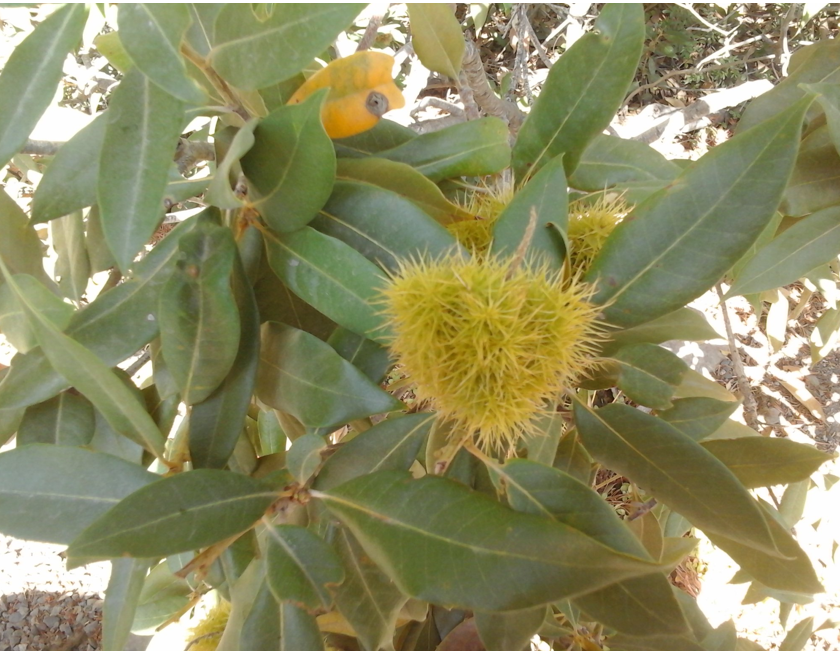
The nuts are encased in a prickly husk.
Use by Wildlife: The nuts are nutritious and eaten by small mammals, but are produced too irregularly to be a major component of their diet. Jays enjoy them, too. Golden Chinquapin is the only known host to the Golden Streak Butterfly. This Butterfly is a Washington State threatened species and listed as sensitive by the US Forest Service. It has been found associated with the Skamania County population but has not been found within the Mason County population.
Links:
Consortium of Pacific Northwest Herbaria
WTU Herbarium Image Collection, Plants of Washington, Burke Museum
Jepson Manual, University of California
Ladybird Johnson Wildflower Center
USDA Forest Service-Fire Effects Information System
Native Plants Network, Propagation Protocol Database (a related species)
Native American Ethnobotany, University of Michigan, Dearborn

